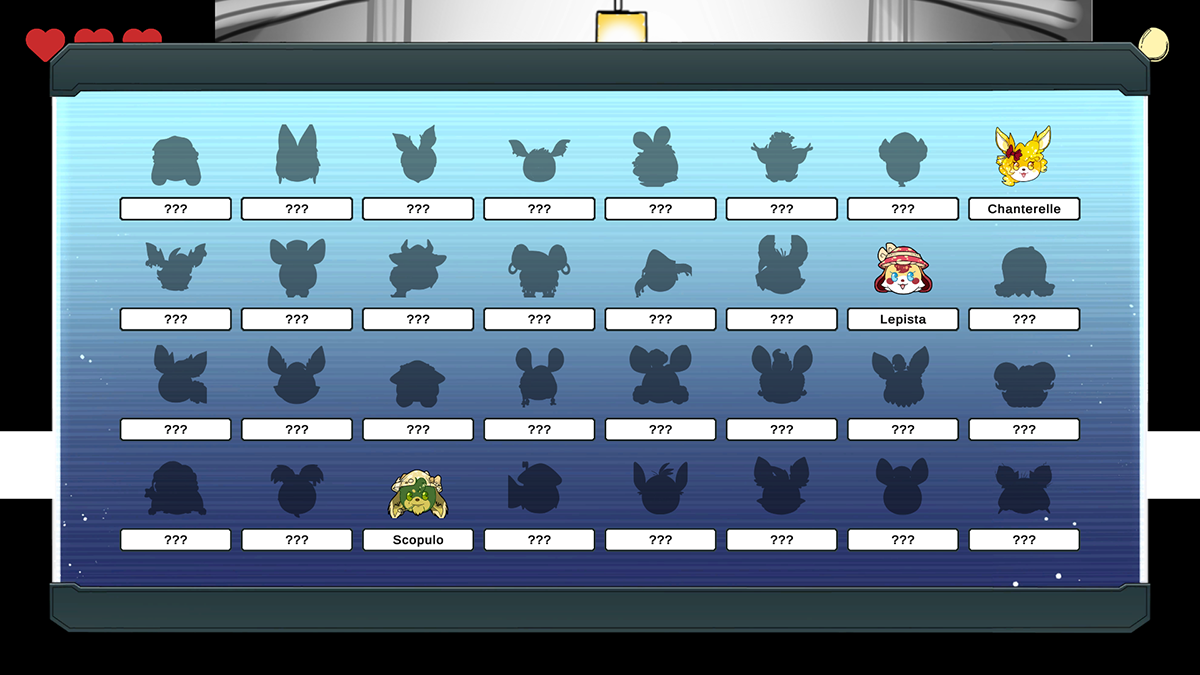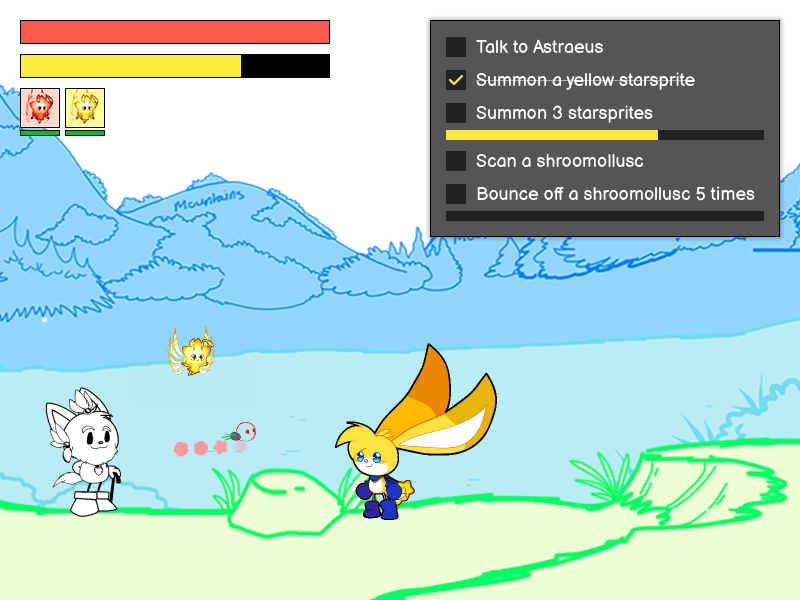Rescuing kuparkukes
Published by James on 30/01/2023Since our last blog post two weeks ago – with the game’s most basic mechanics built, and a solid mechanism in place for saving and loading – we’ve dedicated some time to thinking about what exactly it is we’re making. We’ve always known that we’re developing a 2D platforming game featuring Kinoko the kuparkuke, but what exactly will Kinoko be doing in this game? We’d never really discussed the player’s objectives in much detail before now.
When we really thought about all the things we want the player to do, we ended up breaking our game design down into four key ‘objectives’. We’re going to keep the fourth one under wraps for now, because it’s quite different to the others, but we can tell you about three of them today.
But, before we can start, we have to tell you just a little bit about the game’s story. Without giving too much away, the Enoki village has been raided by alien poachers, and it’s all Kinoko’s fault for leading them there. Spare for a few, the villagers – Kinoko’s own family – have now been scattered across the galaxy, sold into slavery, or worse. It’s up to Kinoko to track them down and bring them safely back to Fungaia.
The first objective has to do with exploration. This game is all about a kuparkuke being the first of his kind to leave Fungaia and explore outer space, and we want that to be reflected in the gameplay. The galaxy will be a fun and interesting place to explore, with different planets to see and new species to encounter. We want the player to feel as excited to explore these new environments as Kinoko himself. We also want these environments to be fun to play about in, so, as well as creating interesting places for Kinoko to explore, this also covers the work we’ve been doing up to this point on creating a nice platforming experience.
The second objective is all about finding the kuparkukes and bringing them home. As Kinoko explores each planet, he’ll need to find and rescue kuparkuke abductees. Only by finding and rescuing every single one of these kuparkukes will Kinoko be able to complete his mission and return back home triumphant. Until then, he’ll be able to return to Fungaia at any point to check in with an unamused Chief Chaga, who’ll keep him up to date on the kuparkukes he’s rescued so far, and those he has yet to find.
And the third objective is about hunting down the villains behind it all, and teaching them a lesson they’ll never forget. Unlike the whole rescuing the kuparkukes thing, which can be done at any time and in any order, hunting down and defeating the villains is the game’s primary means of progression. If Kinoko wants to leave Fungaia for the next part of his mission, he’ll need to fight his way through legions of enemies and mini-bosses, before finally confronting the planet’s final boss, who holds intelligence on the whereabouts of more kuparkukes, and the boss who guards them.
Today, we want to focus on that second objective: rescuing kuparkukes.
To get us started on this major chunk of the game’s development, one of the things we’ve added to the game’s codebase this past fortnight has been support for additional maps, including building interiors. We were always going to need additional maps, but specifically we’ve added a map for the Enoki village, which is going to work quite a bit differently to all the game’s other maps.
Referred to internally as the ‘Enoki village safe-zone’, Enoki is like a central hub not just for the Fungaia world, but for the entire game. Whenever Kinoko rescues a kuparkuke, they’ll be returned safely back to Enoki, and there Kinoko will be able to stop and chat to them whenever he visits. Every one of them will be able to have short conversations with Kinoko, but we plan for quite a few of them to offer meaningful benefits every time they’re spoken to, so the village is definitely a place every player will be wanting to return to often.
When the player first starts the game – and before they have begun exploring Fungaia and rescuing the kuparkukes that got abducted – the village is going to feel empty and haunting, which we’d like to see reflected in the graphics, the music, and the overall vibe of the place. Structures will be seen smoking and in ruins. As you begin rescuing kuparkukes, and these kuparkukes return home to begin rebuilding, you’ll see the village slowly come back to life, with kuparkukes seen working and socialising together and visible repairs being made, and the music becoming gradually more upbeat.
You’ll also be able to enter at least a few of the village’s mushrooms (yes, kuparkukes live in mushrooms if you didn’t know) as the game progresses – but the most important destination for anyone just starting out will be the chief’s mushroom. Here, you’ll be able to meet both Astraeus, former chief of the Enoki tribe and dispenser of wisdom and tutorials, and Chaga, the new, relatively inexperienced chief who is concerned primarily with getting his tribe back in order and helping Kinoko to organise the rescue effort.
It’s through Chaga that the player will be able to view their rescued kuparkukes.
This ‘collection log’, as we’re calling it, is how the player will review their progress towards rescuing all the kuparkukes, in so doing completing their primary goal and unlocking the game’s true ending. They’ll technically be able to ‘complete’ the game (in as far as completing all the levels and defeating all the bosses) without rescuing all of them, but they’ll be not so gently prompted by Chief Chaga to go back around the planets and rescue anyone they missed until everyone’s back home in the Enoki village, safe and sound.
What we’re dealing with at the moment is, as with nearly everything else shown from the game so far, only a prototype. Eventually, we’d like to add lots more functionality in this area. Something we’re really keen on doing with this game is encouraging self-discovery. It’s pretty common in this day and age for players to turn to online walkthroughs, or YouTube videos, when they get stuck in a game. Whilst there’s absolutely nothing wrong with this, we want to discourage it by providing just enough information in-game that we can gently nudge players in the right direction, without giving too much away. We might do this by adding helpful – but deliberately vague – hints as to each kuparkuke’s ‘last known whereabouts’, for instance.
There will no doubt be other collectables that can be picked up during the course of the game, but Chief Chaga isn’t concerned with those. Perhaps some of the other kuparkukes around the village, once rescued, will help the player track those other collectables – and maybe they’ll even offer Kinoko some rewards in return for his kind assistance.
Anyway, I think we’ve said enough about this particular aspect of the game for now. In terms of development, most of the underlying functionality is already complete – it just needs a bit of polish, so that it actually feels rewarding and engaging to play. Although some players may just enjoy fighting enemies and taking on the bosses, we’d really like rescuing the kuparkukes to be an objective that every player enjoys and feels driven to do. We’re going to continue working on this for a little while longer, and with any luck we’ll even pluck up the courage to produce a short video demonstration in the near future!






